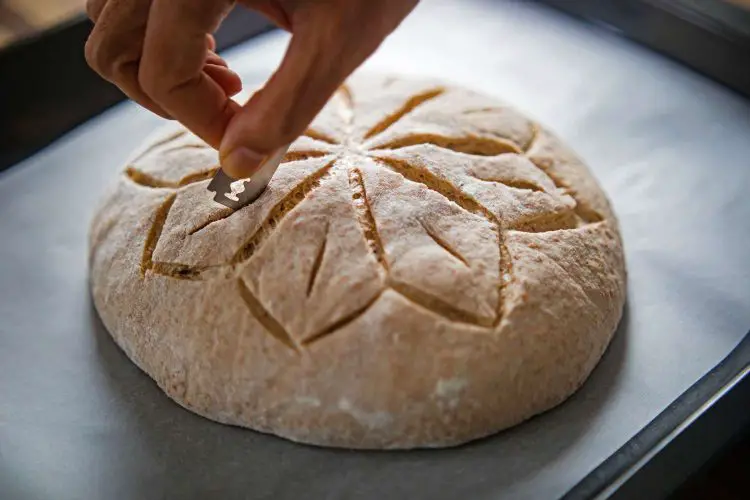Have you ever seen a baker score bread before baking it? It’s quite a sight to behold.
But what’s the purpose of scoring bread, and is it really necessary?
Let’s explore the answers to these questions.
Contents
What Does Scoring Bread Refer To?
Scoring bread refers to making shallow cuts in a loaf of bread prior to baking it. This can take many forms including diagonal, horizontal, and circular cuts.
Many bakers use a special blade called a lame for this process, but some are creative enough to use other tools such as razor blades or even kitchen knives!

While scoring bread may look complex, the technique has been used for centuries and is actually quite simple once you get the hang of it.
How to Score Bread?
The art of scoring bread dough is an essential step in bread baking.
Scoring bread dough allows the heat from the oven to penetrate the dough and create a beautiful, even bake. It also helps with rising and gives your loaf of bread its desired shape.
Let’s explore how to score different types of bread for the perfect bake.
1. Tools Needed for Scoring Bread Dough:
You will need a few tools before you can begin scoring your dough.
First, you will need a sharp knife or razor blade. This is necessary to make clean, even lines in the dough that will allow it to rise properly and create an even texture throughout the loaf.
You should also have some flour on hand so you can lightly dust your work surface and your hands as you work with the dough.
Finally, it’s helpful to have a ruler on hand so you can measure out how deep you want your cuts to be for each loaf.
2. Scoring Different Types of Bread Dough
The type of bread you are baking will determine how deep your cuts should be and what kind of design or pattern you should use when scoring it.
For example, French baguettes require shallow cuts made at an angle across the top of the loaf so that they get that signature “ear” shape when they are baked.
On the other hand, ciabatta loaves require deep cuts with straight edges all around them.
For sourdough boules, you should make several shallow slashes in a cross-hatch pattern around the top of the loaf.
Tips for Scoring Bread Dough Successfully:
When scoring any type of bread dough, there are a few tips that can help ensure success every time:
- Always use cold water; warm water will activate certain enzymes in the yeast which could affect its ability to rise properly as it bakes.
- Make sure each cut is clean and even; this will help ensure an even bake throughout your entire loaf!
- Take care not to overwork or knead your dough too much; this could cause it to become too dense once cooked!
- If possible, let your scored loaves rest before baking; this will give them time to rise further and develop flavor!
Is Scoring Bread Necessary?
The answer depends on what kind of bread you’re making and what kind of texture you’re looking for.
For example, if you’re making a rustic-style loaf that requires an open crumb structure (think baguettes), then yes – scoring your loaves is essential because it will help create that open structure.
On the other hand, if you’re making sandwich-style loaves (like ciabatta) then scoring isn’t necessary because they don’t require an open crumb structure and won’t benefit from steam escaping during baking.
What Happens if You Don’t Score Bread?
If you don’t score your bread before baking it then you run into several issues.
First of all, there’s no way for you to manage how your loaf will expand or where those rips and cracks will occur. This means that your final product won’t look as neat or uniform as one that was scored beforehand.
1. Steam Builds Up
Additionally, if too much steam builds up within your loaf then it can cause significant tearing along those random lines and ruin your entire bread-baking experience!
2. Undercooked Center:
The second issue with not scoring bread is that you may end up with an undercooked center due to a lack of steam release during baking.
When left unchecked during baking, too much steam build-up can lead to the center of your loaf being undercooked while leaving the crust overly browned and burnt.
This also gives off an unappetizing appearance since nobody wants crunchy yet limp pieces of bread!
3. Uneven Texture
Finally, not scoring can also lead to uneven texture throughout your finished product because parts of it are able to rise more than others due to a lack of control over where exactly heat escapes from within each individual piece.
Can I Use an Exacto Knife to Score Bread?
Yes, you can use an Exacto knife or any other sharp blade to score bread dough.
It’s important to remember that when scoring the dough, you should make long, even cuts in order to make sure your finished product looks neat and uniform.
Additionally, it’s best to start with shallow cuts and gradually increase the depth as needed for each type of bread you’re making.
How Do You Score Bread Smoothly?
Let’s take a look at the steps for scoring your own perfect loaves.
1. Kneading Techniques
Kneading is an essential step in making bread dough. Not only does it help to mix together all the ingredients, but it also helps create the texture and structure of the final loaf.
Kneading for about 10 minutes should do the trick—just be sure not to overdo it! If you knead too much, your dough will become tough and hard when baked.
To knead properly, push down on the dough with one hand while pulling up on the opposite side with your other hand.
Then rotate 90 degrees and repeat this motion until your dough has reached a silky-smooth texture.
2. Shaping Your Loaf
Once you’ve finished kneading your dough, it’s time to shape it into a loaf.
- Start by rolling out your dough into a long rectangular shape that is roughly four times as wide as it is tall. Then fold one end of the rectangle over itself until it meets the center of the rectangle.
- Repeat this process for each side until you have a large square of dough that looks like an envelope or package (with 4 layers).
- Finally, roll this package back out into a long rectangular shape and place in on a baking sheet lined with parchment paper.
Scoring Your Loaf Before baking, use a sharp knife to score diagonal lines across the top of your loaf about 1/4 inch deep—this will help give your loaf its traditional “artisanal” look as well as help release steam during baking so that your loaf doesn’t become too dense or heavy in texture.
Be sure not to score too deeply or else your slices will be too thin or irregularly shaped when cut open after baking!
Do You Score Bread Before or After the Second Rise?
It is best to score your bread before the second rise. This will give the dough enough time to proof and expand properly before baking for a nice, even texture throughout your loaf.
After all the hard work you’ve put into making your dough from scratch, you’ll want to make sure it looks as perfect as possible when it comes out of the oven.
Scoring your bread is an easy way to achieve this and can make all the difference between a beautiful homemade loaf and one that looks like it was made in a factory!
Why Does My Bread Deflate When I Score It?
This is usually due to too much steam being released during the scoring process.
When left unchecked during baking, too much steam build-up can lead to the center of your loaf being undercooked while leaving the crust overly browned and burnt.
This also gives off an unappetizing appearance since nobody wants crunchy yet limp pieces of bread!
To avoid this issue, make sure to score your bread lightly and evenly. This will ensure that the steam escapes at a controlled pace as it bakes which should result in an evenly cooked loaf with no deflating!
Should I Score My Bread Before or After Proofing?
It is best to score your bread after proofing.
This will help ensure that the dough has had enough time to rise and become light, airy, and easy to work with when scoring.
Scoring it before proofing can result in a dense loaf that does not rise as much or look as good when baked.
Should I Score Bread in a Loaf Pan?
No, it is not necessary to score bread in a loaf pan. The steam released during baking will have nowhere to escape if your bread is baked in a pan, resulting in a gummy or heavy-textured loaf.
Therefore, it is best to score and bake your bread on a parchment-lined baking sheet for the best results!
What Is a Bread Scoring Tool Called?
A bread scoring tool is called a lame (pronounced lah-may).
It looks like a razor blade attached to the end of a handle and is used for making precise, shallow cuts in your dough before baking.
This allows steam to escape from the loaf which gives it its artisanal look and helps ensure even cooking throughout.
Can Any Bread Be Scored?
Yes, most types of bread can be scored. In fact, scoring your dough is recommended for all types of loaves including sourdough, whole wheat, and oat-based recipes.
However, it is important to note that the shape and depth of the slashing may vary depending on the type of bread you are making.
For example, scoring a sourdough loaf with deep cuts will yield a different look and texture than if you were to score it in shallow slashes.
Conclusion:
Scoring bread dough is both an art and a science—you want neat lines that contribute aesthetically but also allow for proper rising during baking as well as good texture throughout the finished product.
With practice and careful attention to detail, anyone can become proficient at scoring their own loaves of bread like a pro!
So next time you’re ready to make some homemade artisanal loaves, don’t forget these tips when it comes time to score them!
Amazon and the Amazon logo are trademarks of Amazon.com, Inc, or its affiliates.

